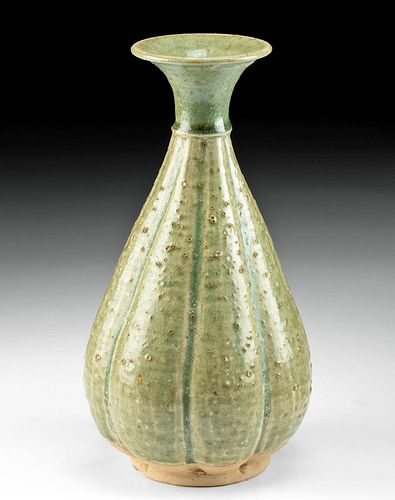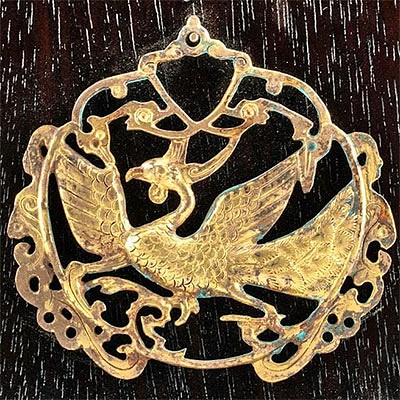10th C. Korean Koryo Dynasty Celadon Vase
Lot 114
About Seller
Artemis Fine Arts
686 S Taylor Ave, Ste 106
Louisville, CO 80027
United States
Selling antiquities, ancient and ethnographic art online since 1993, Artemis Gallery specializes in Classical Antiquities (Egyptian, Greek, Roman, Near Eastern), Asian, Pre-Columbian, African / Tribal / Oceanographic art. Our extensive inventory includes pottery, stone, metal, wood, glass and textil...Read more
Categories
Estimate:
$800 - $1,200
Absentee vs Live bid
Two ways to bid:
- Leave a max absentee bid and the platform will bid on your behalf up to your maximum bid during the live auction.
- Bid live during the auction and your bids will be submitted real-time to the auctioneer.
Bid Increments
| Price | Bid Increment |
|---|---|
| $0 | $25 |
| $300 | $50 |
| $1,000 | $100 |
| $2,000 | $250 |
| $5,000 | $500 |
| $10,000 | $1,000 |
| $20,000 | $2,500 |
| $50,000 | $5,000 |
| $100,000 | $10,000 |
| $200,000 | $20,000 |
About Auction
By Artemis Fine Arts
Jun 17, 2021
Set Reminder
2021-06-17 10:00:00
2021-06-17 10:00:00
America/New_York
Bidsquare
Bidsquare : Ancient & Ethnographic Art Through The Ages
https://www.bidsquare.com/auctions/artemis-gallery/ancient-ethnographic-art-through-the-ages-7094
Ancient art from Egypt, Greece, Italy and the Near East, as well as Asian, Fossils, Pre-Columbian, Native American, African / Tribal / Oceanic, Fine art, and much more! All categories, all price ranges... all legally acquired and guaranteed to be as described or your money back. Artemis Fine Arts info@artemisfinearts.com
Ancient art from Egypt, Greece, Italy and the Near East, as well as Asian, Fossils, Pre-Columbian, Native American, African / Tribal / Oceanic, Fine art, and much more! All categories, all price ranges... all legally acquired and guaranteed to be as described or your money back. Artemis Fine Arts info@artemisfinearts.com
- Lot Description
East Asia, Korea, Koryo Dynasty, ca. 10th to 13th CE. A tall, fluted, sand-glazed vessel with a piriform shape accented by a narrow, conical neck and a flared mouth. The stoneware is covered with olive-green glaze with additional bits of sand, giving it an intriguing textured exterior. The body has deep vertical grooves across its exterior surfaces that imbue it with a strong, gourd-like presence. The unglazed base reveals the original tan color of the buffware. An attractive example with a unique surface and a captivating presentation. Size: 6" Diameter x 10.25" H (15.2 cm x 26 cm)
To create this ware, artisans apply a wash of slip (liquefied clay), which contains a high proportion of iron, to the body of the stoneware before glazing. The iron interacts with the glaze during the firing and colors it one of various shades of green. First made in China, celadon was exported to India, Persia, and Egypt in the Tang dynasty (618 to 907 CE), to most of Asia in the Song (960 to 1279 CE) and Ming (1368 to 1644 CE) dynasties, and to Europe in the 14th century. The ware was popular because of its beauty; the Chinese also valued it because it resembled jade. Adding to its popularity was a widely believed superstition suggesting that a celadon dish would break or change color if poisoned food were put into it.
Korean celadons of the Koryo period had a glaze that varied from bluish green to a putty color. Many of the forms were lobed, based on the melon or the gourd. Chinese potters, noted for originating the practice, fired their celadons in brick kilns, but Korean artisans used traditional mud kilns that effectively blocked the flow of oxygen to produce a brilliant celadon tone.
Wares were both mold-made and wheel thrown. An incision technique enabled the clay surface to be adorned with subtle linear designs. Korean potters adapted and refined celadon technology from China to create distinctively Korean ceramics revered by elites in Korea, China, and Japan alike.
Provenance: ex-Ashland University Museum, Ashland, Ohio, USA
All items legal to buy/sell under U.S. Statute covering cultural patrimony Code 2600, CHAPTER 14, and are guaranteed to be as described or your money back.
A Certificate of Authenticity will accompany all winning bids.
We ship worldwide and handle all shipping in-house for your convenience.
#164879Minor chipping to the base. A label had been placed on a lower portion, and later removed leaving partial remnants. Otherwise, excellent condition and fully intact.Condition
- Shipping Info
-
All shipping is handled in-house for your convenience. Your invoice from Artemis Gallery will include shipping calculation instructions. If in doubt, please inquire BEFORE bidding for estimated shipping costs for individual items.
-
- Buyer's Premium



 EUR
EUR CAD
CAD AUD
AUD GBP
GBP MXN
MXN HKD
HKD CNY
CNY MYR
MYR SEK
SEK SGD
SGD CHF
CHF THB
THB














